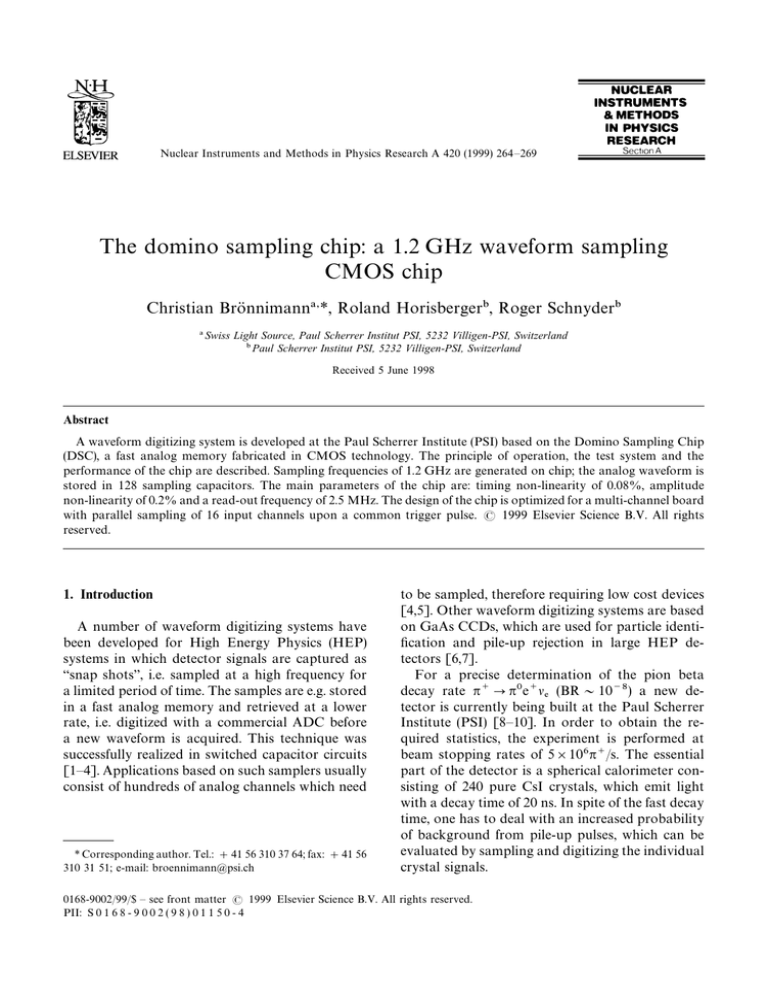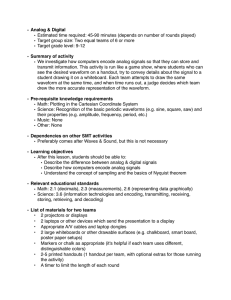
Nuclear Instruments and Methods in Physics Research A 420 (1999) 264—269
The domino sampling chip: a 1.2 GHz waveform sampling
CMOS chip
Christian Brönnimann *, Roland Horisberger, Roger Schnyder
Swiss Light Source, Paul Scherrer Institut PSI, 5232 Villigen-PSI, Switzerland
Paul Scherrer Institut PSI, 5232 Villigen-PSI, Switzerland
Received 5 June 1998
Abstract
A waveform digitizing system is developed at the Paul Scherrer Institute (PSI) based on the Domino Sampling Chip
(DSC), a fast analog memory fabricated in CMOS technology. The principle of operation, the test system and the
performance of the chip are described. Sampling frequencies of 1.2 GHz are generated on chip; the analog waveform is
stored in 128 sampling capacitors. The main parameters of the chip are: timing non-linearity of 0.08%, amplitude
non-linearity of 0.2% and a read-out frequency of 2.5 MHz. The design of the chip is optimized for a multi-channel board
with parallel sampling of 16 input channels upon a common trigger pulse. 1999 Elsevier Science B.V. All rights
reserved.
1. Introduction
A number of waveform digitizing systems have
been developed for High Energy Physics (HEP)
systems in which detector signals are captured as
“snap shots”, i.e. sampled at a high frequency for
a limited period of time. The samples are e.g. stored
in a fast analog memory and retrieved at a lower
rate, i.e. digitized with a commercial ADC before
a new waveform is acquired. This technique was
successfully realized in switched capacitor circuits
[1—4]. Applications based on such samplers usually
consist of hundreds of analog channels which need
* Corresponding author. Tel.: #41 56 310 37 64; fax: #41 56
310 31 51; e-mail: broennimann@psi.ch
to be sampled, therefore requiring low cost devices
[4,5]. Other waveform digitizing systems are based
on GaAs CCDs, which are used for particle identification and pile-up rejection in large HEP detectors [6,7].
For a precise determination of the pion beta
decay rate p>Ppe>l (BR&10\) a new de
tector is currently being built at the Paul Scherrer
Institute (PSI) [8—10]. In order to obtain the required statistics, the experiment is performed at
beam stopping rates of 5;10p>/s. The essential
part of the detector is a spherical calorimeter consisting of 240 pure CsI crystals, which emit light
with a decay time of 20 ns. In spite of the fast decay
time, one has to deal with an increased probability
of background from pile-up pulses, which can be
evaluated by sampling and digitizing the individual
crystal signals.
0168-9002/99/$ — see front matter 1999 Elsevier Science B.V. All rights reserved.
PII: S 0 1 6 8 - 9 0 0 2 ( 9 8 ) 0 1 1 5 0 - 4
Ch. Bro] nnimann et al. /Nucl. Instr. and Meth. in Phys. Res. A 420 (1999) 264 —269
In order to reduce the costs for the entire waveform digitizing system, the waveforms stored in the
samplers are read-out serially and are multiplexed
into one ADC channel. This on the other hand rises
the read-out dead-time per event introduced in the
detector system, which can usually not be tolerated.
Thus, zero suppression is of high importance for the
successful implementation of a waveform digitizing
system.
This work presents the performance of a dedicated CMOS chip for use with fast analog signals
from an amplifier (e.g., a photomultiplier tube) with
signal amplitudes of several hundred mV. The storage depth of the chip is about 100 ns. It is the final
version of several CMOS circuits designed at PSI
[10—13]. The main advantage of the DSC over
commercially available flash ADCs is its inherent
high sampling speed of 1.2 GHz, the low power
dissipation and the very low cost per chip. The chip
is optimized to be used in a large waveform digitizing system, each chip has a zero suppression circuit.
2. System description
2.1. Operation of the DSC
The chip is realized in the S1DM (1 lm
SACMOS double metal) process offered by Philips
265
Semiconductors AG, Switzerland. The operation of
the DSC consists of a sampling phase and
a readout phase. The principle of the sampling
mechanism is based on the transmission of a logic
pulse through two sequential CMOS inverters. The
average gate delay time for a minimum sized transistor is &400 ps in the present design, resulting in
a delay of approximately 800 ps per inverter pair.
Thus a logical signal propagating through a long
chain of inverters acts like a domino wave (thus the
name domino sampling chip).
The circuit diagram of the DSC is shown in
Fig. 1. A positive edge applied at the GATE pad
starts the domino wave which after every second
inverter connects the read-in line over the switches
S1—S128 to the sampling capacitors C1—C128
(0.2 pF). The charge stored on the capacitors is
proportional to the momentary voltage level on the
input bus. Four additional cells A1—A4 are provided which sample the externally supplied voltage
»
used for an analog chip identification when
""0
read-out in zero suppression mode (see below).
A discharge switch has been implemented for each
cell, which keeps all the sampling capacitors at the
same potential. It prevents the capacitors from
charging up before a waveform is acquired. The
switch is opened by the GATE pulse and closed with
the RBO pulse, i.e. after the read-out of the chip.
Fig. 1. Simplified circuit diagram of the Domino Sampling Chip.
266
Ch. Bro] nnimann et al. /Nucl. Instr. and Meth. in Phys. Res. A 420 (1999) 264 —269
DSCs to one single analog output line connected to
one commercial ADC with an appropriate sized
memory. A full read-out sequence of 16 DSCs corresponds to a dead-time of 0.8 ms, which is not
tolerable. Thus a zero-suppression circuit has been
implemented on each DSC, which prevents the chip
from being read-out, when the analog signal is
below the threshold or not in coincidence with the
GATE-pulse [10]. The zero suppression can be enabled or disabled.
2.2. Experimental setup
Fig. 2. Sampling frequency as a function of the control voltage
VDS. The solid line is fit to the data with the theoretical delay
for 2 inverters and a NMOS transistor.
The speed of the sampling mechanism is controlled by the domino speed voltage VDS, which influences the propagation time of the domino wave. For
values of 2 V(VDS(4.7 V sampling frequencies
between 0.8 and 1.2 GHz are obtained (Fig. 2).
The input signal is DC-coupled to the DSC IN
pad, the input capacitance is approximately 1 pF.
Thus, no internal bandwidth restriction other than
the Nyquist limit is present, i.e. the maximum
detectable frequency in the spectrum of the analog
signal is half the sampling frequency.
The read out of the stored information is done
using a standard 2-phase shift register: The RBI
(read bit in) pulse is clocked through the read-out
shift register with the non-overlapping signals R
and R
. Synchronous with the R
-pulse the cor
responding capacitor is connected over the readout line to the charge-sensitive output amplifier,
which is reset with the R
-pulse. At the 132th
clock cycle, the RBO (read bit out) pulse appears at
the end of the shift register, indicating the successful
read-out of the chip. This pulse disconnects the
amplifier from the output pad, thus enabling
the serial read-out of several DSCs connected to
the same output line. The RBO-pulse can be used as
a RBI for the next chip in the chain. The maximum
read-out frequency is 5 MHz, which corresponds to
a dead-time of 25.6 ls for one DSC.
The final read-out architecture for the pion beta
decay experiment is based on multiplexing 16
The experimental setup comprises a PC board,
on which the DSC resides, NIM trigger electronics,
CAMAC units (ADC, IO-unit, and PDG4222), an
IBM compatible 486 personal computer and dedicated units to supply test waveforms. The PC board
supplies the necessary analog voltages and the
digital signals for the DSC operation. The logic
signals provided to the DSC are TTL signals shifted to “0”"!1.5 V and “1”"3.5 V, relative to
the analog ground. The GATE signal is the trigger for
the domino wave and needs to arrive 20 ns before
the analog signal. From an external 2.5 MHz
sinusoid the read-out clock signals are generated
on board upon arrival of the START pulse. During
the read-out phase, the analog signal line is still
connected to the IN pad, but no distortion of the
output due to further input signals has been
observed.
The analog OUT of the chip and the CONVERT
signal (TTL signal, synchronous to ) are supplied
to a flash ADC which converts the analog data and
stores the digitized information in its internal buffer. The CAMAC crate is controlled via a HYTEC
1331 Turbo CAMAC-PC interface. The gains of
the amplifier on the PCB board and the SIROCCO
III analog input card were chosen such that 1 ADC
count corresponds to approximately 2 mV input
voltage.
The electronics can be triggered by an external
signal, which latches the event coincidence, and
causes the DSC to sample the analog input. The
analog to digital conversion of the “analog information” is begun 1 ls after the sampling and
requires 51.2 ls. Now, a LAM signal is supplied to
the CAMAC-IO and subsequently the CAMAC
Ch. Bro] nnimann et al. /Nucl. Instr. and Meth. in Phys. Res. A 420 (1999) 264 —269
267
ADC is read out. The system is controlled by
a dedicated data-acquisition program written in
C-language. It includes an online analyzer which
displays the acquired waveform and a number of
user defined histograms. The waveform data are
stored to disk for further analysis.
3. Performance
Before each set of measurements a pedestal run
was performed, with the DSC analog IN shorted to
(analog) ground. Pedestals and noise of each bin
were calculated as mean and rms values of 1000
events. The maximum pedestal variation is 2.5
ADC counts, i.e. 5 mV equivalent input voltage.
The noise values are constant over all bins and are
1.3 ADC counts, i.e. 2.7 mV. This value includes the
noise of the complete electronics chain including
the PCB board and the ADC. Especially the onboard generation of the TTL CONVERT pulse for the
ADC has been found to be a major source of
disturbance.
3.1. Amplitude non-linearity
The amplitude non-linearity of the system was
tested using DC voltages supplied by a Kethley
Multimeter. DC-levels between !1 and #1 V
were sampled with 1.2 GHz and read out with
2.5 MHz. For each level 500 events were recorded.
Fig. 3 shows the mean output ADC-value of one
bin as a function of the input DC-level. In the range
of [!300 mV,#400 mV] the peak deviation from
linearity is 0.8 ADC counts, which corresponds to
an amplitude non-linearity of 0.2%. By appropriate
choice of the DSC analog ground level, the range
can be shifted to, e.g., [!700 mV, 0 mV] which is
suitable for the PMT-signals in case of the pion
beta decay experiment. The range is limited by the
setting time of the on-chip output amplifier and can
be increased by decreasing the read-out speed.
3.2. Timing non-linearity
With timing non-linearity we refer to the possible
variation of the inverter gate delays that are responsible for the sampling speed. The timing non-
Fig. 3. (Top) Mean ADC values of 500 events of a single bin as
a function of input voltage. (Bottom) Residuals from the fit, the
error bars are the rms values.
linearity was determined by mapping out the
transition levels between the DSC bins. The negative edge of a NIM signal with an amplitude of
!800 mV and a rise time of 2 ns was applied to
the chip and sampled with 1.2 GHz. With a simple
algorithm, the bin at which the output signal crossed a threshold of !400 mV was determined in
software and filled into a histogram. The delay of
the input signal was chosen such that its edge fell
between bin i and i#1. In order to access all the
bins on the DSC, a coarse delay relative to the GATE
signal of 20—120 ns had to be established; furthermore the delay had to be varied in the range of ps in
order to match the 50—50 transition point between
two neighboring bins. The NIM pulse was generated by using a LeCroy 4222 CAMAC programmable gate and delay generator, which produces precise time delays up to 16.7 ms in 1 ns increments
synchronously with a random trigger input. The
fine delay was established using a coaxial delay
tube, used for high frequency tuning, the length of
which could be varied manually in mm steps be-
268
Ch. Bro] nnimann et al. /Nucl. Instr. and Meth. in Phys. Res. A 420 (1999) 264 —269
Fig. 4. Total delay (coarse#fine) to access transitions between
bins. The solid line is a linear fit to the data (Top). Deviations
from the linear fit (Bottom). The maximum deviation is 80 ps.
Fig. 5. (Top) The response to a 500 mVpp, 25 MHz sine wave
sampled at 1.2 GHz together with the fit (solid line). (Bottom)
The residuals of the fit.
tween 0 and 22 cm. The delay of the device was
33.5$0.5 ps/cm, leading to a maximum delay of
0.736 ns. The combination of coarse delay with the
4222 and the mechanical fine delay made it possible
to reach almost all of the 127 transitions between
bins. From these data the resulting non-linearity
was calculated: As can be seen from Fig. 4, the
maximum deviation from linearity is 80 ps over the
100 ns range, which corresponds to a timing nonlinearity of 0.08% at 1.2 GHz sampling frequency.
The timing non-linearity at a sampling speed of
1 GHz is well below 0.8% and rises to 1.3% at
0.2 GHz.
In Ref. [10], the timing resolution of the previous
version of the DSC (700 MHz) was determined
relative to a Philips Scientific 10C6 FASTBUS
10-bit TDC with a LSB of 100 ps. With a simple
linear interpolation algorithm, a resolution of
200 ps (rms) was obtained. The increased sampling
speed of the present chip should allow timing
resolution of the order of 100 ps.
Least significant bit.
3.3. Tests with sine waves
The response of the DSC to sine waves was
measured by using a WAVETEK 178 50 MHz
waveform synthesizer. Reference measurements of
25 MHz sinusoidal signals with variable amplitudes of the synthesizer were performed with
a TEKTRONIX TDS744 digital scope. The signals
were sampled with 1 GHz/s and the digital data
were analyzed offline. The sinusoidal waveforms
were best fitted with the fundamental 25 MHz sine
wave and a 2% additional 2nd harmonic sinusoid.
Free running sinewaves of different amplitudes
and frequencies were applied to the DSC. A pedestal measurement was performed prior to the
events with sine waves, and pedestals were subtracted from the data. Fig. 5 top panel shows the result
of a 500 mV amplitude, 25 MHz sine wave, plot
Ch. Bro] nnimann et al. /Nucl. Instr. and Meth. in Phys. Res. A 420 (1999) 264 —269
Table 1
DSC parameters and performance under experimental conditions for the given input range
Nr of Bins
Input range
Maximum sampling frequency
Read out frequency
Noise (rms)
Pedestal variation (max)
Timing non-linearity (for 100 ns range)
Amplitude non-linearity (700 mV range)
128
$0.35 V
1.2 GHz
2.5 MHz
2.6 mV
$2.5 mV
0.08%
0.2%
269
integrated on one NIM-board, which leads to very
low costs per digitizing channel. Due to the integrated zero suppression circuit, the (analog) outputs
can be multiplexed onto one ADC with acceptable
dead time. All in all this allows to build a large,
high speed, waveform digitizing system with the
presented performance for costs below 100 SFr per
digitizing channel.
References
ted together with a fit function of the above stated
form. The rms-value of the residuals from the fit,
shown in Fig. 5 bottom panel, is 3 mV. The response of the DSC to the sinusoidal signals is
identical to that of the digital scope.
4. Conclusions and outlook
This work presents the performance of the
Domino Sampling Chip (DSC), a CMOS analog
sampling circuit which is being developed for the
pion beta experiment at PSI. A test system was set
up in order to measure the chip performance.
A summary of the important parameters is shown
in Table 1.
The circuit of the DSC is designed such that a
large number of chips (planned are 128) can be
[1] S. Kleinfelder, IEEE-Trans. Nucl. Sci. 35 (1988) 151.
[2] S. Kleinfelder, IEEE-Trans. Nucl. Sci. 37 (1990) 1230.
[3] G.M. Haller, B.A. Wooley, IEEE J. Solid State Circuits 29
(4) (1994) 500.
[4] G.M. Haller, B.A. Wooley, IEEE Trans. Nucl. Sci. 41 (4)
(1994) 1203.
[5] S.R. Klein et al., IEEE Trans. Nucl. Sci. 43 (3) pt. 2 (1996)
1768.
[6] M. Atiya et al., Nucl. Instr. Meth. A 279 (1990) 180.
[7] D. Bryman et al., IEEE Trans. Nucl. Sci. 38 (2) (1991) 295.
[8] D. Pocanic, A precise measurement of the p>Ppe>m
decay rate, PSI Proposal R-89-01, 1989.
[9] K.A. Assamagan, Ph.D. Thesis, University of Virginia,
1995.
[10] Ch. Brönnimann, Ph.D. Thesis, University of Zürich, 1996.
[11] Monika Brogle, Testing a CMOS Waveform Sampling
Chip, PSI Internal Report, TM-11-90-02, 1990.
[12] Ch. Brönnimann, R. Horisberger, Testing the Domino
Sampling Chip, PSI Internal Report, TM 11-94-02, 1994.
[13] D. Goldner et al., Study of time and charge resolution of
drift chamber pulses using a fast VLSI waveform sampler
chip, PSI-PR-95-10, June 1995.





